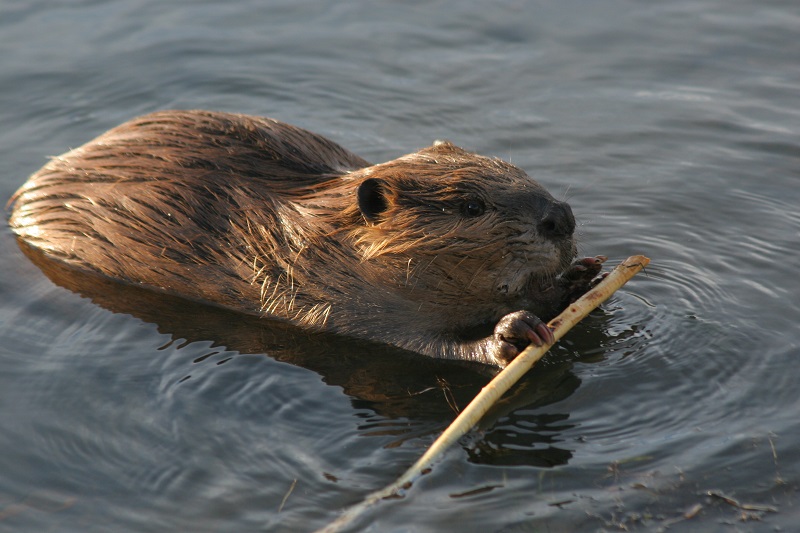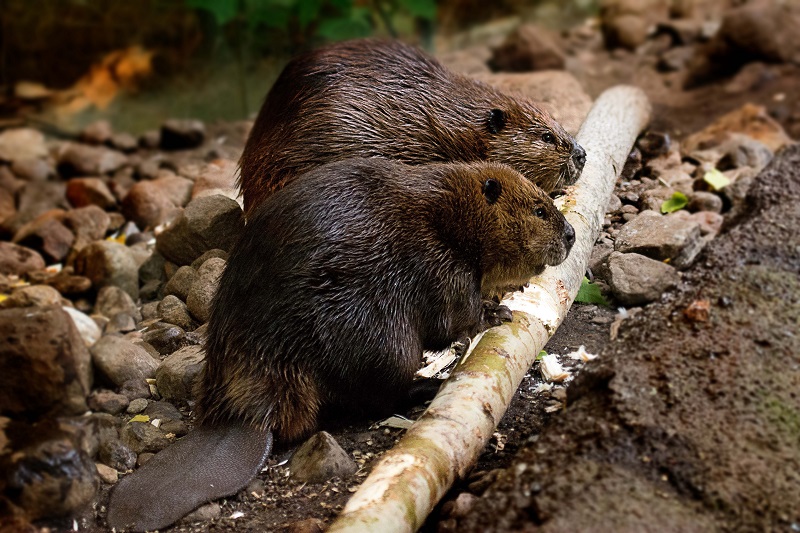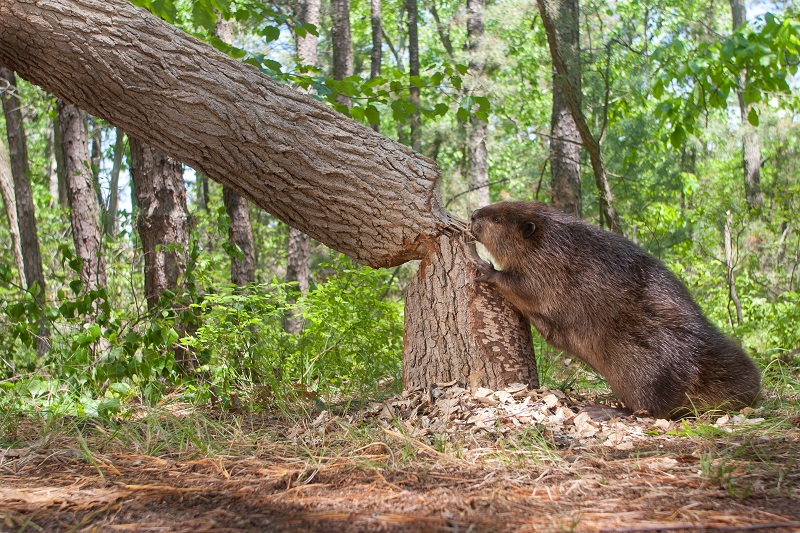
 WildlifeNYC311
WildlifeNYC311 Search all NYC.gov websites
Search all NYC.gov websites
Beavers
Beaver (Castor canadensis)

Introduction
New Yorkers may be surprised to learn that the official state mammal is not a squirrel or a deer. It’s not a coyote, or a raccoon, or any of the other species that often find themselves in the local spotlight either. In fact, New York’s official state mammal is an animal that hardly gets any publicity at all: the beaver (Castor canadensis).
So why do beavers represent New York, considering how seldom they are seen or heard about here in the city? Perhaps it has to do with how much they have in common with the average New Yorker; beavers are hardworking, persistent, and able to adapt their environment to their needs. Or maybe it’s because of the important place beavers hold in New York’s history. In the 1600s, European demand for beaver pelts was very high. Beaver abundance in the New York City area during this time helped spur the city’s development by attracting trappers and traders to the region.
Whatever the reason, beavers have had a tough time here in recent years. Overtrapping, deforestation, and habitat loss caused by New York’s rapid growth led to a sharp decline in their local populations over the decades. Just two centuries after European settlers first arrived, the number of beavers in New York State fell from an estimated 60 million to almost none at all. However, efforts in the early 1900s to reintroduce beavers by releasing them in the Adirondacks have been largely successful. By 1924, upstate beaver populations were thriving again. And in 2007 a beaver was spotted in the Bronx River, marking the first beaver sighting in New York City in over 200 years. Beavers are now present on Staten Island as well, and have been spotted in Manhattan and Brooklyn.

Background
Beavers are nocturnal, meaning they are most active at night. This partially explains why spotting one is so difficult. They spend most of their time in the water, and can be found close to ponds, marshes, lakes, streams, and other permanent water sources. Known as master builders, they prefer areas close to their favorite building materials: trees, rocks, twigs, and mud.
The dams they build serve a number of different purposes. Ponds created by their dams provide a safe area for beavers to build their lodges and allow them to dive underwater to evade predators. Beavers are also more mobile in the water than they are on land, so these ponds make it easier for beavers to transport food and wood back to their lodge too. In the process of building their dams, they can damage local flora and forests. However, their dams also create new habitat for fish, ducks, turtles, frogs, and other wildlife.
Beavers apparently never got the memo that New York apartments are supposed to be tiny. Their lodges are relatively large, extending up to 14 feet at the base and rising up to 6 feet above the water. Inside they feature two levels, and include separate areas for feeding, drying, and sleeping. Lodges are usually spacious enough to hold several family members. They often house mates, their young, and related non-breeding adults. Beavers will often create several tunnel entrances into the lodge, and lodges are usually built with an air vent.
Appearance
Beavers are the largest rodent in North America. They usually weigh between 30 and 60 pounds, and can measure up to 3.5 feet in length. The color of their fur ranges from light brown to nearly black.
Their wide, flat tail is one of their signature features. It can serve a variety of purposes. Beavers use their tails to swim faster, and to help them balance while they are cutting down trees. Beavers also slap their tails on the water to alert their family of danger. They can even store excess fat in their tails and circulate blood into them to help regulate their body temperature. Beavers are also known for their bright-orange teeth, which are continually growing. They are kept at a manageable length through their continuous chewing of food and building materials.
Beavers are uniquely adapted for life in the water. They have lips that close behind their teeth, which allow them to gnaw underwater while still holding their breath. Their back feet are webbed to help them swim faster, and oil glands keep their fur highly water-resistant. They also have a set of transparent eyelids that allow them to see underwater while keeping their eyes closed.
Behavior
Beavers live in small family units numbering between four and six members. They mate for life and reproduce once a year. Breeding occurs in January or February. Young are born in the early summer, in litters of anywhere between one and eight kits. Kits are ready to enter the water within hours of being born, though they still depend on their parents for care.
Their diet consists primarily of woody plant material, and they have been known to eat the leaves, bark, and twigs of a variety of trees. In the summer they can shift their diet to include aquatic vegetation like water lilies and other shoreline plants. During the autumn, they will gather and store food in their dammed-up pond for the upcoming winter. Beaver families can require up to two tons of food in order to last the winter.

• Beavers can swim up to 15 miles per hour and hold their breath for up to 15 minutes at a time.

A beaver transporting a stick.
Introduction
New Yorkers may be surprised to learn that the official state mammal is not a squirrel or a deer. It’s not a coyote, or a raccoon, or any of the other species that often find themselves in the local spotlight either. In fact, New York’s official state mammal is an animal that hardly gets any publicity at all: the beaver (Castor canadensis).
So why do beavers represent New York, considering how seldom they are seen or heard about here in the city? Perhaps it has to do with how much they have in common with the average New Yorker; beavers are hardworking, persistent, and able to adapt their environment to their needs. Or maybe it’s because of the important place beavers hold in New York’s history. In the 1600s, European demand for beaver pelts was very high. Beaver abundance in the New York City area during this time helped spur the city’s development by attracting trappers and traders to the region.
Whatever the reason, beavers have had a tough time here in recent years. Overtrapping, deforestation, and habitat loss caused by New York’s rapid growth led to a sharp decline in their local populations over the decades. Just two centuries after European settlers first arrived, the number of beavers in New York State fell from an estimated 60 million to almost none at all. However, efforts in the early 1900s to reintroduce beavers by releasing them in the Adirondacks have been largely successful. By 1924, upstate beaver populations were thriving again. And in 2007 a beaver was spotted in the Bronx River, marking the first beaver sighting in New York City in over 200 years. Beavers are now present on Staten Island as well, and have been spotted in Manhattan and Brooklyn.

Two beavers chewing on a log.
General InformationBackground
Beavers are nocturnal, meaning they are most active at night. This partially explains why spotting one is so difficult. They spend most of their time in the water, and can be found close to ponds, marshes, lakes, streams, and other permanent water sources. Known as master builders, they prefer areas close to their favorite building materials: trees, rocks, twigs, and mud.
The dams they build serve a number of different purposes. Ponds created by their dams provide a safe area for beavers to build their lodges and allow them to dive underwater to evade predators. Beavers are also more mobile in the water than they are on land, so these ponds make it easier for beavers to transport food and wood back to their lodge too. In the process of building their dams, they can damage local flora and forests. However, their dams also create new habitat for fish, ducks, turtles, frogs, and other wildlife.
Beavers apparently never got the memo that New York apartments are supposed to be tiny. Their lodges are relatively large, extending up to 14 feet at the base and rising up to 6 feet above the water. Inside they feature two levels, and include separate areas for feeding, drying, and sleeping. Lodges are usually spacious enough to hold several family members. They often house mates, their young, and related non-breeding adults. Beavers will often create several tunnel entrances into the lodge, and lodges are usually built with an air vent.
Appearance
Beavers are the largest rodent in North America. They usually weigh between 30 and 60 pounds, and can measure up to 3.5 feet in length. The color of their fur ranges from light brown to nearly black.
Their wide, flat tail is one of their signature features. It can serve a variety of purposes. Beavers use their tails to swim faster, and to help them balance while they are cutting down trees. Beavers also slap their tails on the water to alert their family of danger. They can even store excess fat in their tails and circulate blood into them to help regulate their body temperature. Beavers are also known for their bright-orange teeth, which are continually growing. They are kept at a manageable length through their continuous chewing of food and building materials.
Beavers are uniquely adapted for life in the water. They have lips that close behind their teeth, which allow them to gnaw underwater while still holding their breath. Their back feet are webbed to help them swim faster, and oil glands keep their fur highly water-resistant. They also have a set of transparent eyelids that allow them to see underwater while keeping their eyes closed.
Behavior
Beavers live in small family units numbering between four and six members. They mate for life and reproduce once a year. Breeding occurs in January or February. Young are born in the early summer, in litters of anywhere between one and eight kits. Kits are ready to enter the water within hours of being born, though they still depend on their parents for care.
Their diet consists primarily of woody plant material, and they have been known to eat the leaves, bark, and twigs of a variety of trees. In the summer they can shift their diet to include aquatic vegetation like water lilies and other shoreline plants. During the autumn, they will gather and store food in their dammed-up pond for the upcoming winter. Beaver families can require up to two tons of food in order to last the winter.

A beaver cutting down a tree.
Fast Facts• Beavers can swim up to 15 miles per hour and hold their breath for up to 15 minutes at a time.
• The beaver became New York’s official state mammal in 1975, and can be found on the official seal of New York City.
• Beaver teeth are orange because their enamel contains iron, which makes their teeth stronger and more resistant to decay.
• Beavers secrete a brown substance called castoreum which smells like vanilla and has been used in perfumes and some food products for decades.
Tips for Coexistence
• Do not interfere with beaver dams. Altering and/or removing a beaver dam in any way requires consultation with the New York State Department of Environmental Conservation’s (DEC) Bureau of Wildlife and requires a permit. Contact the New York State DEC before interacting with beaver dams in any way.
Tips for Coexistence
• Do not interfere with beaver dams. Altering and/or removing a beaver dam in any way requires consultation with the New York State Department of Environmental Conservation’s (DEC) Bureau of Wildlife and requires a permit. Contact the New York State DEC before interacting with beaver dams in any way.
• Observe and enjoy beavers from a distance. Beavers are shy, and getting too close can cause them to get stressed. Always watch beavers from a distance.
• Protect your plants and trees. In the process of acquiring building materials and food, beavers can cause damage to plants and trees. Install fencing and wrap trees in wire mesh to protect them from beaver damage.
• Report your beaver sightings. Knowing where beavers are currently living helps the City to track their expansion and ensure that they are being properly managed. You can report beaver sightings anywhere in the city with WildlifeNYC’s Report a Sighting feature.
References
New York State Department of Environmental Conservation (2004). The Beaver.
References
New York State Department of Environmental Conservation (2004). The Beaver.


